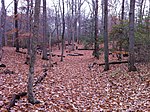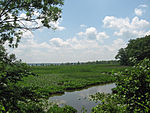George Mason

George Mason (December 11, 1725 [O.S. November 30, 1725] – October 7, 1792) was an American planter, politician, Founding Father, and delegate to the U.S. Constitutional Convention of 1787, one of three delegates present who refused to sign the Constitution. His writings, including substantial portions of the Fairfax Resolves of 1774, the Virginia Declaration of Rights of 1776, and his Objections to this Constitution of Government (1787) opposing ratification, have exercised a significant influence on American political thought and events. The Virginia Declaration of Rights, which Mason principally authored, served as a basis for the United States Bill of Rights, of which he has been deemed a father. Mason was born in 1725, most likely in what is now Fairfax County, Virginia. His father died when he was young, and his mother managed the family estates until he came of age. He married in 1750, built Gunston Hall, and lived the life of a country squire, supervising his lands, family and slaves. He briefly served in the House of Burgesses and involved himself in community affairs, sometimes serving with his neighbor George Washington. As tensions grew between Great Britain and the North American colonies, Mason came to support the colonial side, using his knowledge and experience to help the revolutionary cause, finding ways to work around the Stamp Act of 1765 and serving in the pro-independence Fourth Virginia Convention in 1775 and the Fifth Virginia Convention in 1776. Mason prepared the first draft of the Virginia Declaration of Rights in 1776, and his words formed much of the text adopted by the final Revolutionary Virginia Convention. He also wrote a constitution for the state; Thomas Jefferson and others sought to have the convention adopt their ideas, but they found that Mason's version could not be stopped. During the American Revolutionary War, Mason was a member of the powerful House of Delegates of the Virginia General Assembly, but to the irritation of Washington and others, he refused to serve in the Continental Congress in Philadelphia, citing health and family commitments. In 1787, Mason was named one of his state's delegates to the Constitutional Convention and traveled to Philadelphia, his only lengthy trip outside Virginia. Many clauses in the Constitution bear his stamp, as he was active in the convention for months before deciding that he could not sign it. He cited the lack of a bill of rights most prominently in his Objections. He also wanted an immediate end to the slave trade and a supermajority requirement for navigation acts, fearing that restrictions on shipping might harm Virginia. He failed to attain these objectives, and again at the Virginia Ratifying Convention of 1788, but his prominent fight for a bill of rights led fellow Virginian James Madison to introduce the same during the First Congress in 1789; these amendments were ratified in 1791, a year before Mason died. Obscure after his death, Mason has come to be recognized in the 20th and 21st centuries for his contributions to the early United States and to Virginia.
Excerpt from the Wikipedia article George Mason (License: CC BY-SA 3.0, Authors, Images).George Mason
White Trail,
Geographical coordinates (GPS) Address Nearby Places Show on map
Geographical coordinates (GPS)
| Latitude | Longitude |
|---|---|
| N 38.66862 ° | E -77.16823 ° |
Address
White Trail
White Trail
22060
Virginia, United States
Open on Google Maps








